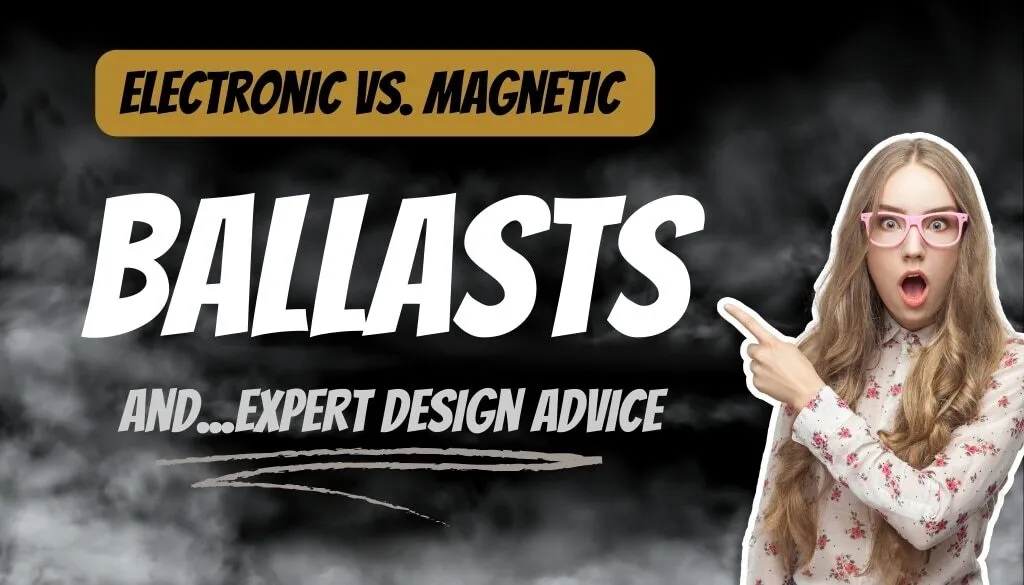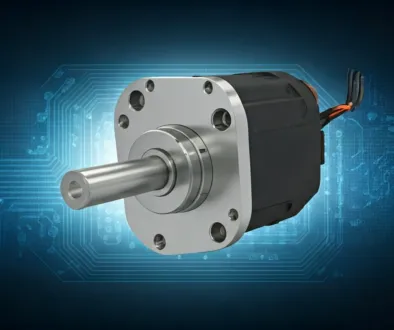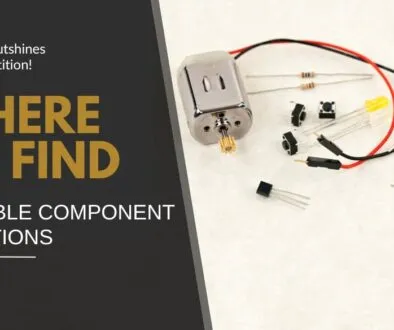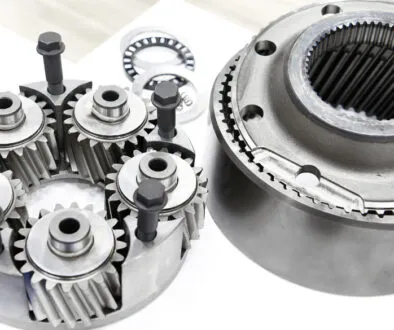Electronic Ballasts vs Magnetic Ballasts
Making the Right Decision for Your Lighting Needs
Selecting the right ballast for your lighting needs is vital to ensure optimal performance and energy efficiency. When choosing between magnetic and electronic ballasts, it’s important to understand the differences and benefits of each.
Magnetic ballasts have been around for decades, but electronic ballasts have gained popularity for their improved features and energy-saving capabilities. Let’s get into the magnetic vs electronic ballast comparison; discussing their features, advantages, and drawbacks.
Hopefully, this guide will help you make an informed decision and find the perfect ballast for your lighting setup.
What is a Light Ballast?
In simple terms, a lighting ballast is a device that regulates and controls the electrical current flowing to a light fixture. It is typically found in fluorescent lamps and other types of discharge lamps.
The main purpose of a ballast is to provide the necessary voltage to start the lamp, then regulate the current to ensure a stable and consistent light output. But why is this task so important and specialized?
Well, fluorescent lamps and discharge lamps require a high voltage to start the ionization process inside the lamp. However, after the lamp ignites, it needs a lower voltage and regulated current to maintain steady and efficient light output. This is where the ballast comes into play.
The ballast acts as a power regulator, controlling the electrical current to provide the requirements of a specific lamp. It limits the current flowing through the lamp and prevents it from overheating or burning out. The ballast helps filter out any electrical interference or noise that may affect the lamp’s performance.
In summary, the main purpose of a lighting ballast is to start and control the electrical current flowing through a lamp, ensuring a stable and efficient light output. Without the proper fluorescent ballast, fluorescent lamps and discharge lamps would not be able to function properly, leading to flickering lights, reduced lifespan, and overall poor performance.
Let’s now discuss each ballast type.
Magnetic Ballasts
Magnetic ballasts, also known as chokes, are an older legacy technology. They operate by limiting the current flowing through a lighting circuit. This is achieved by utilizing the electromagnetic field generated when current passes through a tightly wound coil.
The coil effectively traps the majority of the current, allowing only a small amount to pass through. The thickness of the coil determines the power output of the ballast.
While magnetic ballasts may be considered a crude method compared to electronic ballasts, their simplicity makes them durable and less prone to damage on construction sites or during installation.
These have been largely replaced by electronic ballasts. It is worth noting that magnetic ballasts are sometimes used as direct replacements for older fixtures that were originally designed for them. Magnetic Ballasts are still prominent in fluorescent light installations, but the rise in LED lighting has shrunk the whole sector.
Electronic Ballasts
Electronic ballasts are essential components in modern lighting systems, providing efficient and flicker-free operation. These ballasts work by converting the incoming AC or DC voltage from the power supply into a high-frequency voltage. The ballast controls the flow of electricity to the lamp, regulating the current and voltage to optimize the performance of the light source. By using electronic components, these ballasts can operate at high frequencies, resulting in improved lighting quality. 
Advantages of Electronic Ballasts
Here are six key benefits of using electronic ballasts for UVC germicidal lamps:
1. Higher Energy Efficiency
Electronic ballasts are known for their superior energy efficiency compared to magnetic ballasts. Electronic ballasts convert electricity more efficiently, resulting in less energy loss during conversion.
This means that electronic ballasts can power germicidal bulbs using less electricity, ultimately lowering energy costs and reducing environmental impact.
2. Longer Lamp Life
One of the significant advantages of electronic ballasts is their ability to extend the lifespan of UVC lamps. They provide a stable and consistent power supply to the lamps, reducing stress on the lamp components.
This stable power supply helps prevent fluctuations that can shorten the lamp’s lifespan. With electronic ballasts, UV lamps can operate more reliably and last longer, reducing the frequency of lamp replacements and maintenance costs.
This longer lamp life also contributes to overall cost savings and improved efficiency in UVC disinfection systems.
3. Various Output/Input Configurations
Electronic ballasts offer greater flexibility in terms of output and input configurations compared to magnetic ballasts. Electronic ballasts can be designed to accommodate a wide range of lamp sizes and wattages, allowing for customization based on specific application requirements.
This versatility makes electronic ballasts suitable for various UV-C germicidal lamp setups, from small portable units to large-scale disinfection systems. Users can optimize the performance of dozens of lamp types different disinfection needs.
4. Reduced Flickering
Flickering is a common issue associated with magnetic ballasts, which can result in inconsistent UV-C light output and reduced disinfection efficacy. Electronic ballasts, on the other hand, provide a stable and flicker-free input power supply to UV-C lamps, ensuring consistent and reliable performance.
The absence of flickering in electronic ballasts contributes to more effective disinfection processes by maintaining a steady output of UV-C light.
This consistent light output helps ensure thorough and uniform disinfection in various industries, from healthcare facilities to food processing plants.
5. Quieter Operation
Electronic ballasts are known for their silent and vibration-free operation compared to magnetic ballasts. Magnetic ballasts, due to their design, emit a high-pitched whine or hum the entire time they are running. The electronic components in electronic ballasts produce minimal noise and vibration, creating a quieter working environment when powering UV-C germicidal lamps.
This quiet operation is particularly beneficial in settings where noise levels need to be minimized, such as hospitals, laboratories, or offices.
6. Dimming Capabilities
Electronic ballasts offer the added advantage of dimming capabilities, allowing users to adjust the intensity of UV-C light output as needed.
This flexibility in light output control enables users to customize the disinfection process based on specific requirements or environmental conditions. For example, in certain applications where a lower intensity of UV-C light is sufficient, dimming capabilities can help conserve energy and extend lamp life.
Disadvantages of Electronic Ballasts
Higher Initial Cost: Electronic ballasts have a higher upfront cost than magnetic ballasts. This initial investment is often offset by the long-term energy savings and reduced maintenance expenses offered by electronic ballasts.
Compatibility Issues: While electronic ballasts are compatible with most fluorescent lamps, some older models may not be compatible. It is essential to ensure compatibility before retrofitting existing fixtures with electronic ballasts.
Magnetic Vs Electronic Ballasts: Which is Better?
When it comes to lighting, both magnetic and electronic ballasts play an important role in powering fluorescent lamps.
Magnetic ballasts have been around for decades and operate on electromagnetic principles. They are reliable and cost-effective, but they do have drawbacks. Magnetic ballasts tend to be bulky, which limits their application in compact spaces.
They also produce a noticeable flickering effect, which can be distracting and even cause eye strain. Moreover, magnetic ballasts have a lower power factor, resulting in wasted energy and increased electricity consumption.
On the other hand, electronic ballasts have gained popularity over the last decade due to their numerous advantages. Firstly, they are much smaller and lighter than their magnetic counterparts, making them ideal for compact lighting fixtures.
Electronic ballasts also eliminate flickering, resulting in a more comfortable and visually appealing lighting experience. They have a higher power factor, which means they utilize energy more efficiently, reducing electricity costs.
Furthermore, electronic ballasts offer improved lamp performance, providing higher light output and extended lamp life. They are also compatible with various standardized lamp types, offering versatility in lighting choices.
Additionally, electronic ballasts are more environmentally friendly, as they produce less heat and noise than magnetic ballasts.
Electronic ballasts clearly outperform magnetic ballasts in terms of efficiency, versatility, and overall lighting quality. Embracing this technology optimizes lighting conditions and contributes to a greener and more sustainable future.
Starting Technologies for Our Germicidal Ballasts
Instant Start ballasts: These ballasts are designed to provide an instant ignition for UVC germicidal lamps. When the power is turned on, an electrical pulse is delivered to the lamp, causing it to immediately light up.
Instant start ballasts are commonly used in applications requiring infrequent on/off cycles, such as air purifiers or HVAC systems.
Rapid Start ballasts: Rapid start ballasts provide a preheating process for UVC germicidal lamps before ignition. When power is supplied, the ballast sends a low-voltage current through the lamp’s electrodes, heating them up.
This partial preheating process helps to extend the lamp’s lifespan and ensures a reliable ignition. Rapid start ballasts are often used in applications where lamps are cycled only a few times a day, such as in hospitals or laboratories.
Programmed Start ballasts: Programmed start ballasts offer the most advanced technology for UVC germicidal lamps. They provide a soft start for the lamps by gradually increasing the voltage and current during ignition.
This gentle start, full preheat method significantly reduces stress on the lamp and prolongs its lifespan. Programmed start ballasts are commonly used in applications where lamps are continuously switching between on and off, such as in water treatment systems or food processing facilities. They provide the highest level of lamp protection, reducing maintenance costs while maximizing energy efficiency.
At ISL Products, we offer customized electronic ballasts for UVC lamps for a variety of applications across the lighting industry. These ballasts are designed to optimize the performance and longevity of UVC lamps, ensuring efficient and reliable operation in applications like air and water purification, surface disinfection, and sterilization.
We understand the importance of tailored solutions and work closely with customers to develop electronic ballasts that meet their specific requirements.Contact us today to discuss your UVC lamp ballast needs and find the perfect solution for your application.





